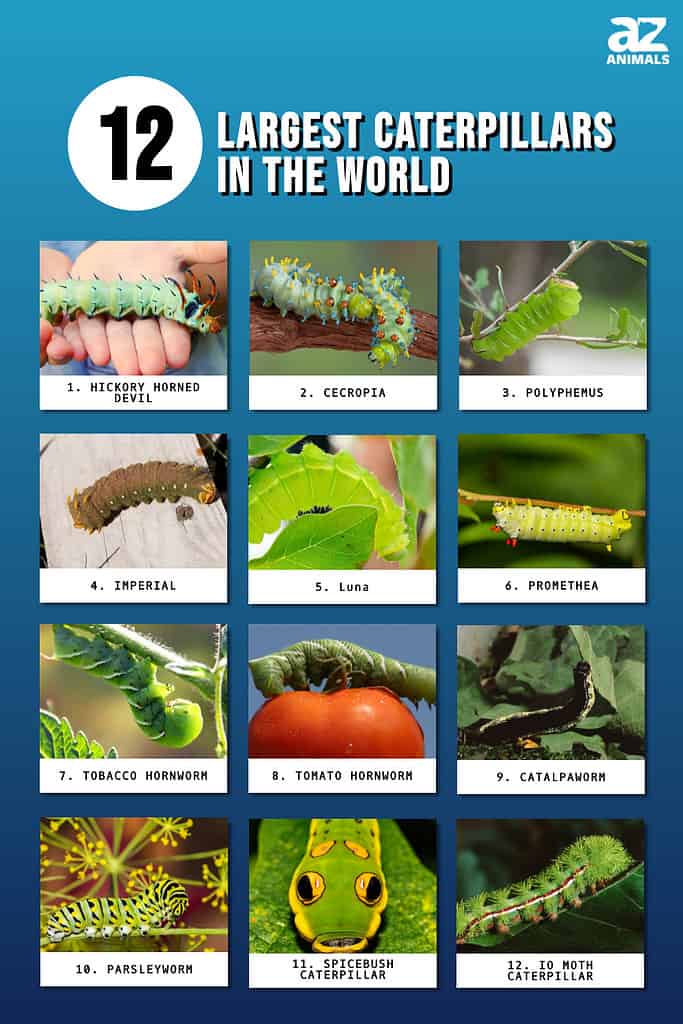
Beautiful colors, markings, and features characterize these creatures during the four stages of their metamorphosis. The egg becomes a larva or caterpillar, then a pupal stage before the butterfly or moth emerges. We are looking at the larva or caterpillar stage, seeking the largest caterpillars in the world.
Before we enjoy the beautiful varieties of butterflies and moths, these creatures are in a lifecycle phase called caterpillars. The characteristics of caterpillars include many colors and patterns. Some are furry, some spikier. Thick hair, thin hair, spines, knobs, or split tails all distinguish them. Caterpillars also have preferences for what type of leaf they eat and the tree they nest. Favorites include the walnut, butternut, white walnut, hickories, pecan, sumacs, sweetgum, and persimmon. The persimmon is said to host the largest and fastest-growing larvae.
Flies from the tachinid and sarcophagi species and the braconid wasp are natural enemies of the caterpillar. Butterfly cocoons offer more protection, as they are hard chrysalis. Moth caterpillars are typically in a silky cocoon and are more vulnerable. Summer or early fall is when you will frequently see caterpillars scrunch and stretch out again as they move on leaves, trees, or even the ground in front of you.
#12 Io Moth Caterpillar (Io Moth – Automeris Io – Fabricius)
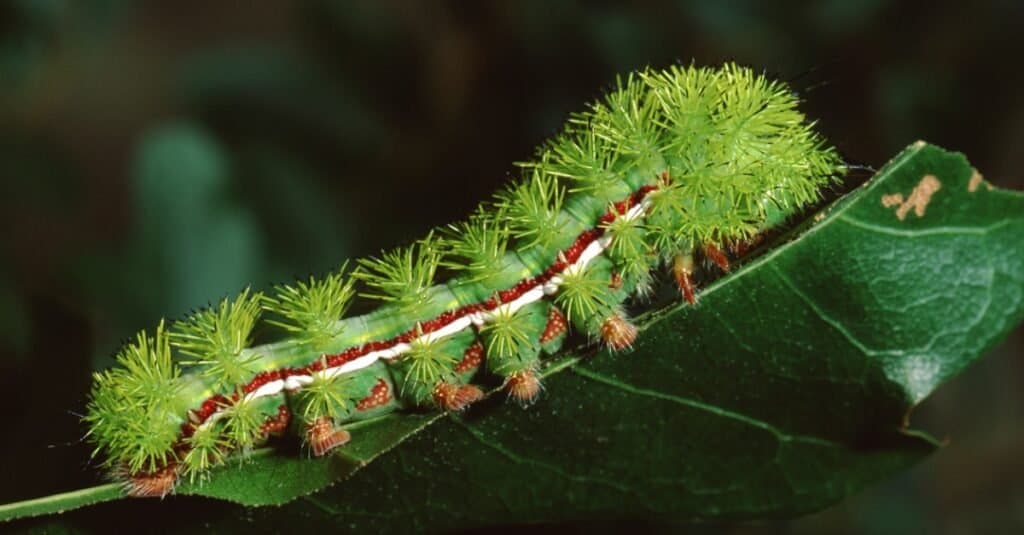
The io moth
caterpillar
has bristles across its body
©iStock.com/Weber
The io moth caterpillar has a bright green color with a distinctive stripe of white and shades of red or purple along the sides. Bristles cover its back that has a series of hairs on them. Up to three inches long, this species enjoys feasting on birch, blackberry, cherry, clover, elm, hackberry, hibiscus, oak, poplar, sassafras, willow, and wisteria. Try not to handle this caterpillar. The hairs on their backs will sting, and the effects can last from minutes to hours. Some people will have an allergic reaction to the venom. You will see this larva throughout the summer months.
#11 Spicebush Caterpillar (Spicebush Swallowtail – Papilio troilus – Linnaeus)
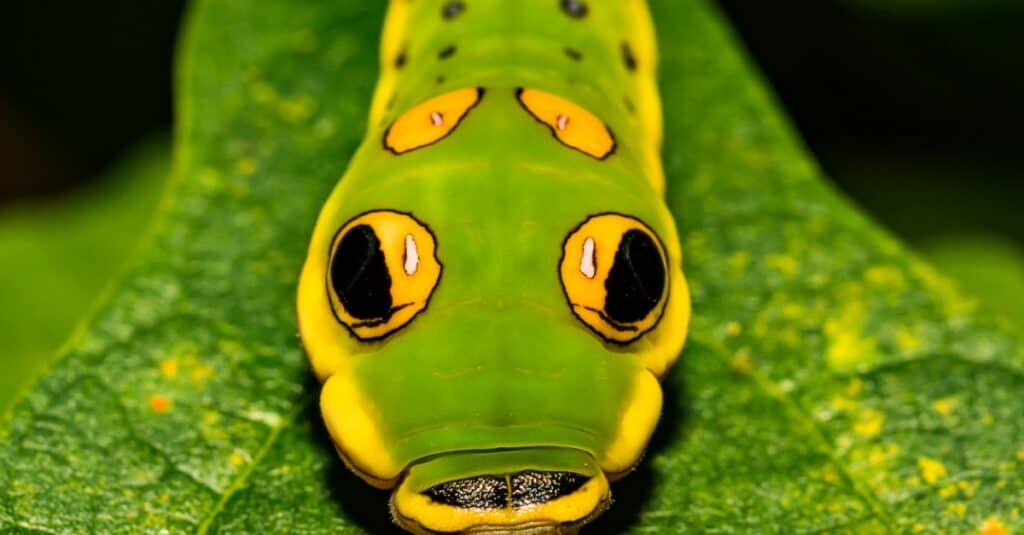
The spicebush caterpillar has markings that appear to be eyes
©iStock.com/JasonOndreicka
Smooth and green, the spicebush caterpillar has yellow or orange eyespots on the sides of the head. It has two more yellow spots on the back of the head area. The folded leaves of spicebush, sassafras, sweet bay, prickly ash, and shrubs are the nesting place and the primary food source for this species. There usually is one hatch per year and a second in favorable climates.
#10 Parsleyworm (Black Swallowtail – Papilio polyxenes asterias – Stoll)
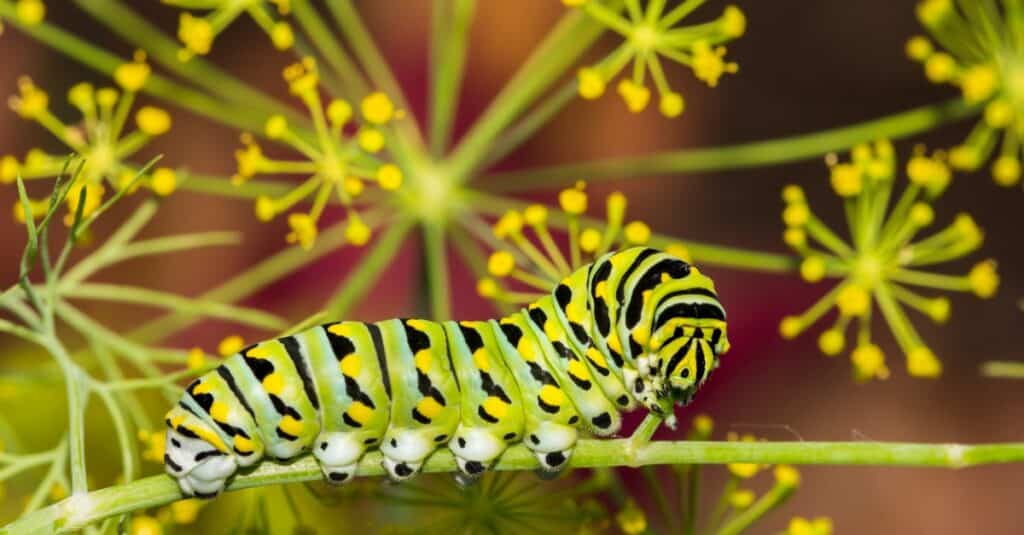
Parsleyworms are also known as black swallowtails.
©Jay Ondreicka/Shutterstock.com
Parsleyworm is also called celeryworm, carrotworm, American swallowtail, or black swallowtail. Pale or yellow-green with bands across the back in black and white have yellow-orange spots that give this caterpillar a beautifully striped look. Food for this variety of caterpillar is parsley, parsnip, celery, carrot, dill, caraway, Queen Anne’s lace, and other plants. Farmers and gardeners often find them a pest in their crops. There may be two or more hatches per year.
#9 Catalpaworm (Catalpa Sphinx Moth – Ceratomia catalpa – Boisduval)
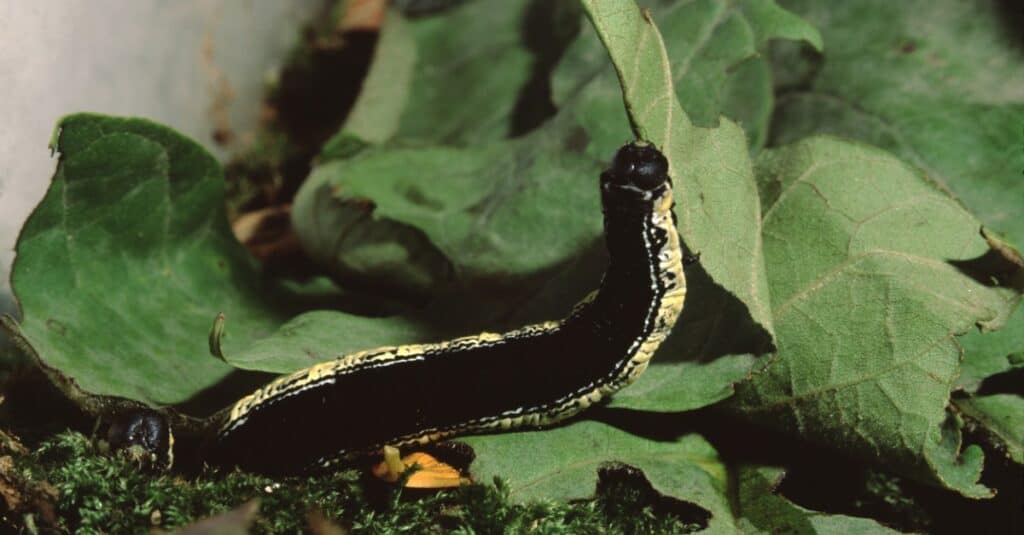
©Liz Weber/Shutterstock.com
The catalpa worm or catalpa sphinx moth is either velvet black with green and black stripes or yellow-tan with stripes. It has a trait that looks like a black horn at the tail end. Munching on catalpa tree leaves is this caterpillar’s favorite meal, and they have been known to ravage a tree completely. Reaching three inches, this caterpillar will burrow underground for the next stage of its development. This species will hatch twice per year.
#8 Tomato Hornworm (Five Spotted Hawk Moth – Manduca quinquemaculato – Haworth)
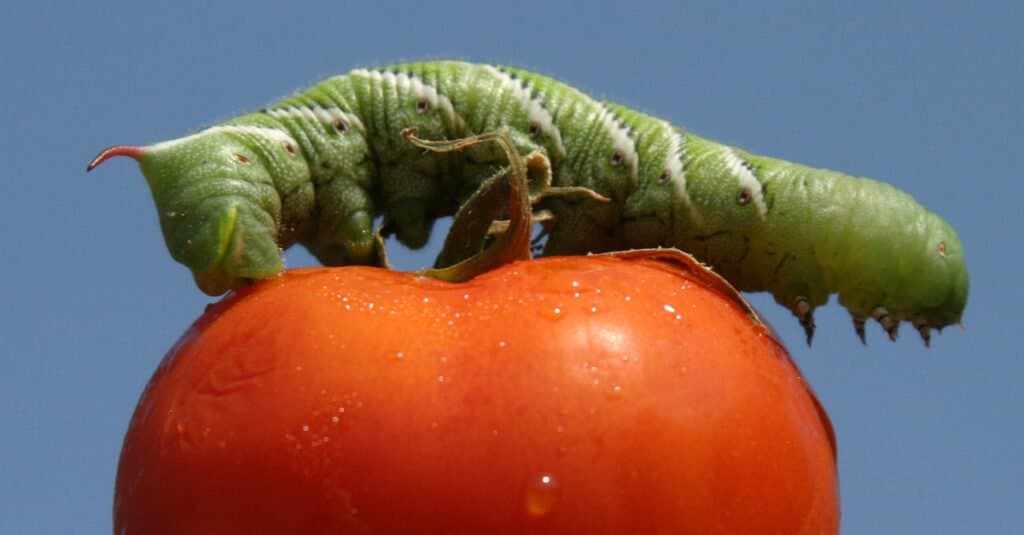
A tomato hornworm feasts on tomatoes, among other produce.
©mikeledray/Shutterstock.com
The tomato hornworm or five-spotted hawk moth is green and has eight curved stripes on the sides of the body. The tail has a black hora that sticks straight up. Feasts include tobacco, tomato, eggplant, pepper, potato, and weeds. The larval stage lasts an average of 28 to 36 days.
#7 Tobacco Hornworm (Carolina Sphinx Moth – Manduca sexta – Linnaeus)
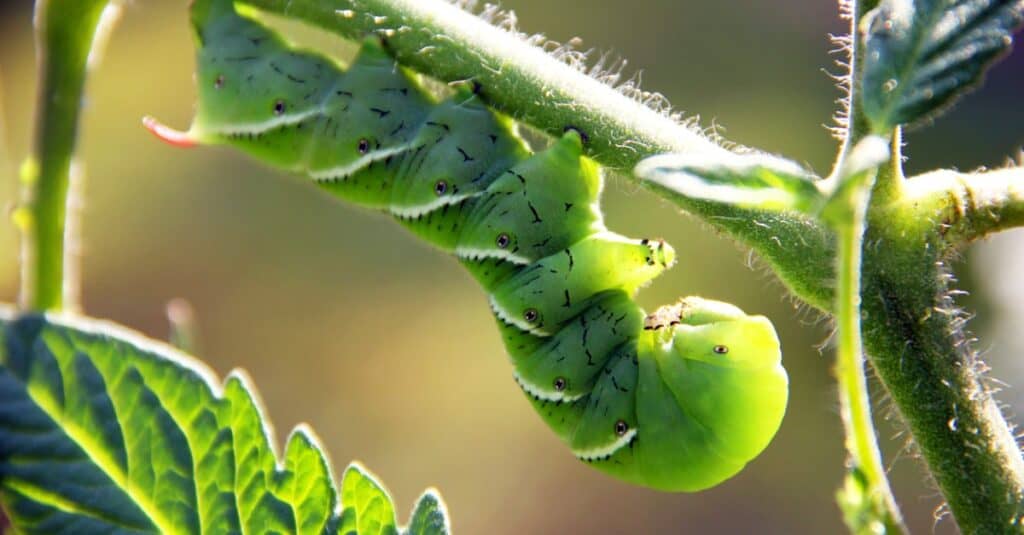
Tobacco hornworms have seven stripes alongside their body.
©iStock.com/lauraag
The Carolina sphinx moth or tobacco hornworm is green with seven diagonal stripes on each side of the body. The tail end has a red curved horn. The tobacco hornworm is similar to the tomato hornworm and enjoys the same tobacco, tomato, eggplant, pepper, potato, and weeds. The larval stage averages the same 28 to 36 days.
#6 Promethea (Promethea Moth – Callosamia promethea – Drury)
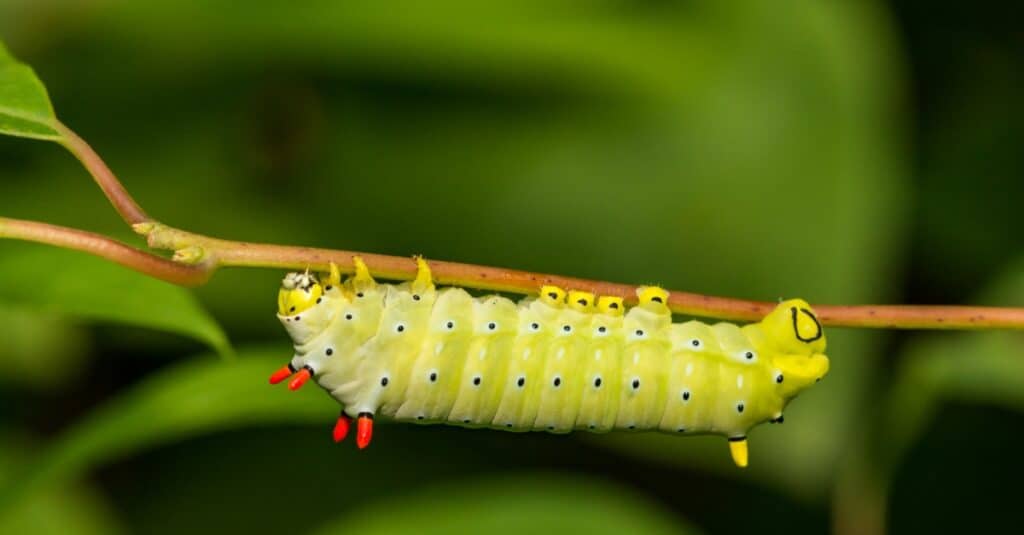
Promethea moths have distinctive spikes.
©Jay Ondreicka/Shutterstock.com
The promethea moth is also called the silk moth. Smooth green-blue, this caterpillar has spikes. There are four red-orange ones near the front and one on the yellow tail end. Four small black-blue spots are seen on segments along the back. There are two facial spots on the head. The spicebush, cherry, sassafras, tuliptree, willow, poplar, sweetgum, ash, apple, pear, lilac, wild plum, birch, buttonbush, basswood, maple, and chokeberry are the food of choice for the Promethea Moth. The cocoon in a leaf becomes rolled up in the silk and will stay there for 42 to 54 days before emerging.
#5 Luna (Luna Moth – Actias luna – Linnaeus)

Luna moths have a translucent appearance.
©iStock.com/ErikaMitchell
The moon moth, also called luna moth, is translucent pale green. It has a pale yellow line that runs along the lower side. This caterpillar will be up to four inches when fully grown. Preferred food choices are the alder, cherry, walnut, hickory, oak, sweetgum, birch, butternut, beech, willow, chestnut, pecan, hazelnut, and persimmon tree leaves. Unlike many other moths, the Luna Moth cocoons on the ground among fallen leaves.
#4 Imperial (Imperial Moth – Eagles imperialis – Drury)
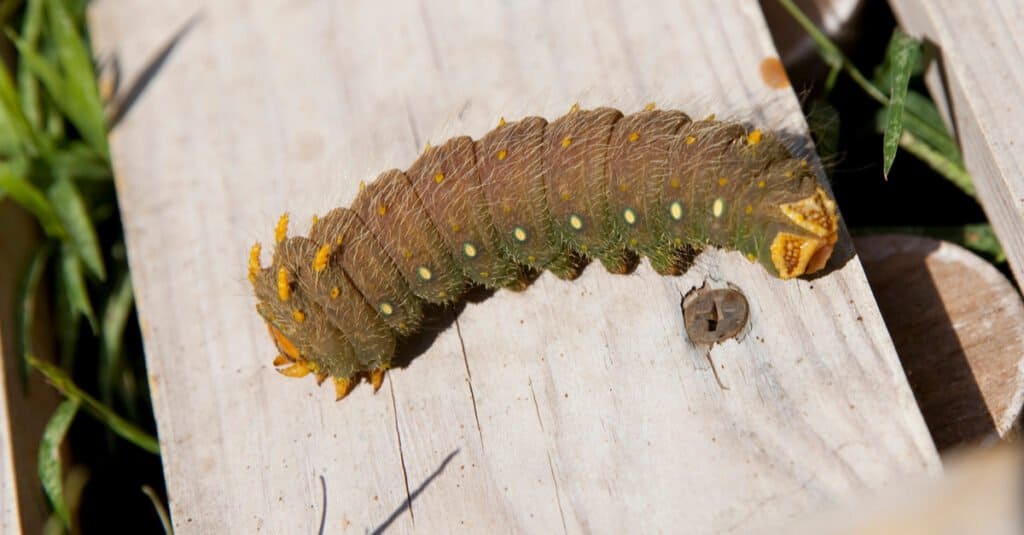
Imperial caterpillars are covered in stiff hairs.
©Jeanne Raises/Shutterstock.com
The larvae of the imperial moth are yellow-green, tan, or dark brown on the upper side and hunter-green on the lower side. They are covered with short, stiff, light blue-green hairs. There are breathing holes along the sides that are white with an outline of aqua and black. Four long, sharp yellow spines are along the back of the orange-yellow head. They feed on trees and shrubs of spruce, pine, oak, maple, sycamore, cherry, birch, alder, elm, sweetgum, sassafras, beech, cedar, and walnut. Burrowing under the soil after a 42-day larval stage, this caterpillar will wait out winter.
#3 Polyphemus (Polyphemus Moth – Artheraeo polyphemus – Cramer)
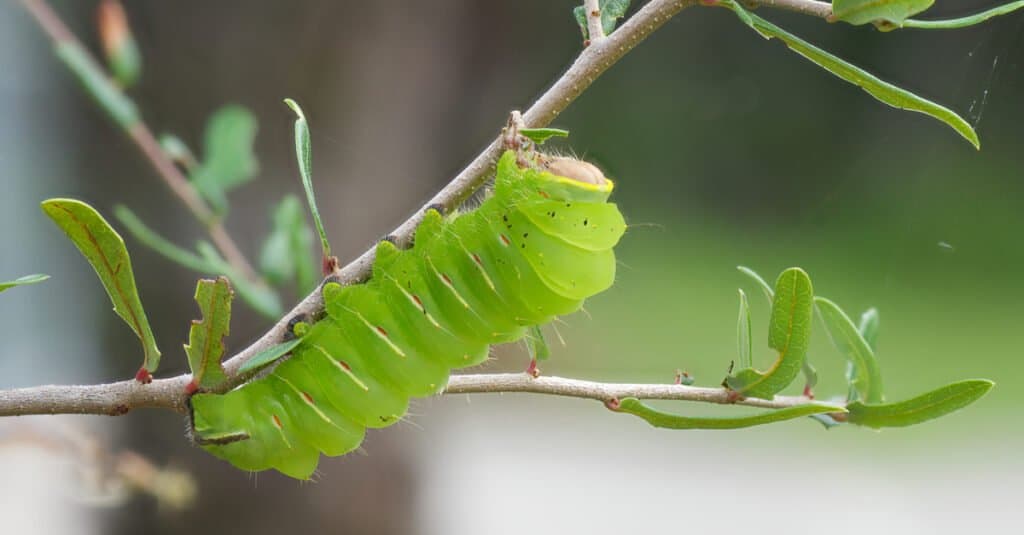
Polyphemus caterpillars can grow up to four inches long.
©Chase D’animulls/Shutterstock.com
The Polyphemus caterpillar is fat, accordion-like, pale green with sparse hair. It will reach up to four inches long. Preferred food includes oak, hickory, elm, maple, birch, apple, boxelder, cherry, chestnut, willow, ash, grape, pine, and rose bushes. The cocoon resembles parchment. It is round and rigid. The caterpillar forms its cocoon in the tree or shrub fed and will stay there for 48-50 days.
#2 Cecropia (Cecropia Moth – Hyalophora cecropia – Linnaeus)
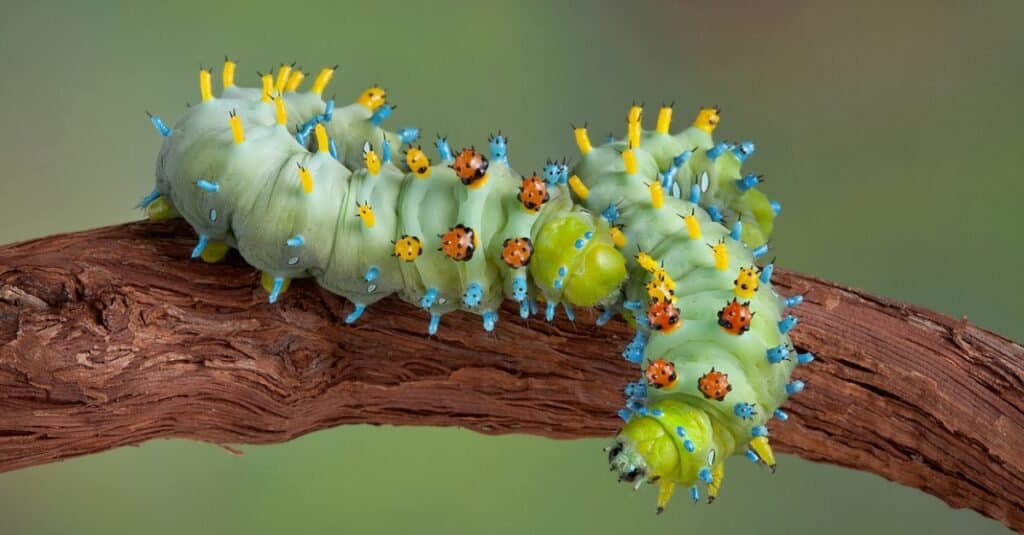
The cecropia caterpillar prefers trees like apple, walnut, and beech.
©Cathy Keifer/Shutterstock.com
The robin moth or cecropia moth is black with short bristles reaching four inches long and ¾ inch in diameter. The caterpillar will change from black to green with a blue tinge. It has two pairs of orange and eight yellow knob-like tubercles on the back. There are smaller pale blue and yellow-white tipped tubercles along the sides. This caterpillar chooses wild cherry, plum, elderberry, maple, willow, boxelder, apple, birch, lilac, walnut, pecan, elm, beech, and poplar trees and shrubs as its food choices.
#1 Hickory Horned Devil (Regal Moth – Citheronia regalis – Fabricius)
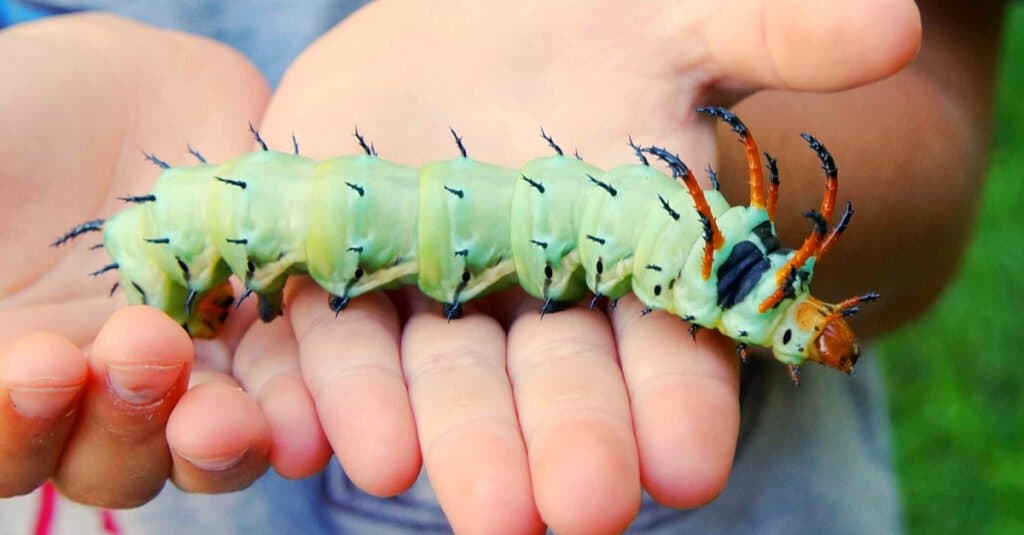
Hickory-horned devils have a distinctive appearance.
©Matt Jeppson/Shutterstock.com
The hickory horned devil is the larva of the regal moth or royal walnut moth. It earns the name because of its appearance. There are five pairs of long, curving hornlike features on the back of the head area. The remaining body area has shorter spikes that are orange with black tips. The body is a deep blue-green to tan color. Our longest caterpillar grows between five and six inches long and ¾ inches in diameter. Feeding for 37 to 42 days, it chooses hickory, walnut, butternut, pecan, ash, lilac, persimmon, sycamore, sumac, and sweetgum leaves. They burrow underground.
Conclusion
From spiky protuberances to colorful markings and every little thing that makes a caterpillar unique, we have discovered some that are truly remarkable. We see them as annoying crawling larva that eats the leaves, flowers, fruits, and wood we have in our yards.
We don’t see them in fruit until the fruit is harvested and prepared for the dinner table. Caterpillar larva sometimes produces webbing in or near our closets and can damage clothing and other linens. In our lawns, we may see yellowing or browning of our grass from caterpillar activity. Our furry caterpillar friends can entirely consume leaves and flowers. Woody plants and trees may find caterpillars boring into them for food and shelter.
Despite these minor annoyances for us, the importance caterpillars have for our ecosystem is undeniable. They are a food source for other animals, but they are also pollinators. They help fertilize plants, spread the pollen, and help plants to reproduce.
We love to observe many types of caterpillars when we come across them in nature. We even enjoy picking them up and letting them crawl on our hands and arms from time to time. Once past the caterpillar stage, the beauty we experience in butterflies and moths is simply mesmerizing. This creature is truly a beauty!
Summary of The 12 Largest Caterpillars in the World
Here’s a summary of the 12 largest caterpillars in the world, their length, and the moths they turn into:
| Rank | Caterpillar | Size | Moth |
|---|---|---|---|
| 1 | Hickory horned devil | 5-6 inches long | Regal Moth/Royal Walnut Moth |
| 2 | Polyphemus caterpillar | 4 inches long | Robin Moth/Cecropia Moth |
| 3 | polyphemus caterpillar | 4 inches long | Polyphemus Moth |
| 4 | Imperial caterpillar | 3-5 inches long | Imperial Moth |
| 5 | Luna caterpillar | 4 inches long | Luna Moth/Moon Moth |
| 6 | Promethea caterpillar | 2 inches long | Promethea Moth |
| 7 | Tobacco Hornworm | 4 inches long | Carolina Sphinx Moth |
| 8 | Tomato Hornworm | 4 inches long | Five Spotted Hawk Moth |
| 9 | Catalpaworm | 3 inches long | Catalpa Sphinx Moth |
| 10 | Parsleyworm | 2 inches long | Black Swallowtail |
| 11 | Spicebush Caterpillar | 2 inches long | Spicebush Swallowtail |
| 12 | Io Moth Caterpillar | 2 inches long | Io Moth |
The photo featured at the top of this post is © Cathy Keifer/Shutterstock.com
Thank you for reading! Have some feedback for us? Contact the AZ Animals editorial team.







